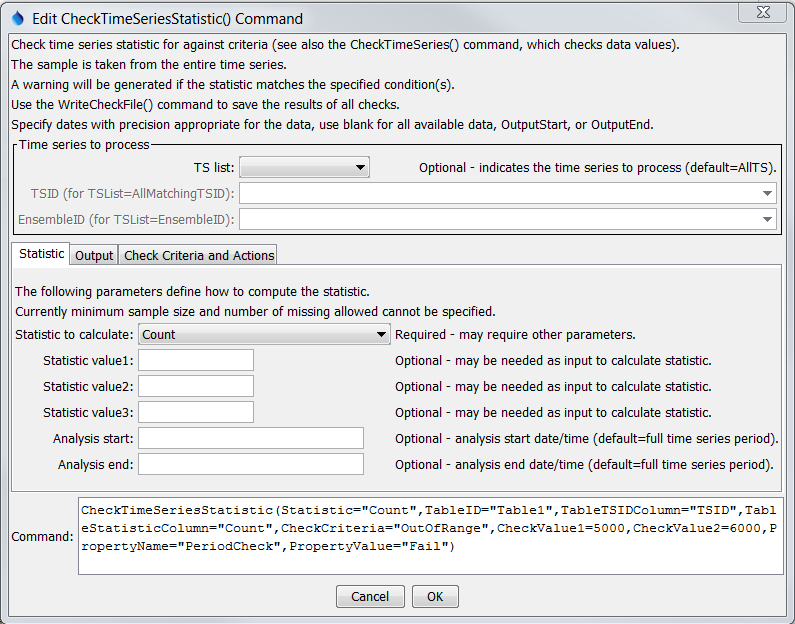TSTool / Command / CheckTimeSeriesStatistic
Overview
The CheckTimeSeriesStatistic command checks a time series statistic against criteria,
for example to perform quality control using full-period statistics.
This command is essentially a combination of the
CalculateTimeSeriesStatistic
command with features similar to the
CheckTimeSeries command; however,
the latter checks individual data values and this command checks a
statistic computed from the entire time series.
The WriteCheckFile command can be used to write a summary of the warnings.
Command Editor
The following dialog is used to edit the command and illustrates the command syntax, in this case to check for time series that have >= 5% missing data values.

CheckTimeSeriesStatistic Command Editor for Statistic Parameters (see also the full-size image)
The following parameters will output the location part of the TSID to a
column named TSID and the missing percentage to a column named MissingPercent in the output table named Table1.

CheckTimeSeriesStatistic Command Editor for Output Parameters (see also the full-size image)
The percentage of missing values is then checked to see if >= 10 and if so the command will
fail and the time series will have a property set MissingPercentCheck=Fail.

CheckTimeSeriesStatistic Command Editor for Criteria and Action Parameters (see also the full-size image)
Command Syntax
The command syntax is as follows:
CheckTimeSeriesStatistic(Parameter="Value",...)
Command Parameters
| Parameter | Description | Default |
|---|---|---|
TSList |
Indicates the list of time series to be processed, one of:
|
AllTS |
TSID |
The time series identifier or alias for the time series to be processed, using the * wildcard character to match multiple time series. Can be specified using ${Property}. |
Required if TSList=*TSID |
EnsembleID |
The ensemble to be processed, if processing an ensemble. Can be specified using ${Property}. |
Required if TSList=*EnsembleID |
Statistic |
Statistic to compute. Refer to the CalculateTimeSeriesStatistic command documentation. |
None – must be specified. |
StatisticValue1 |
Input data required by the statistic. Currently the dialog does not check the value for correctness – it is checked when the statistic is computed. See the CalculateTimeSeriesStatistic command documentation. |
|
StatisticValue2 |
Input data required by the statistic. Currently the dialog does not check the value for correctness – it is checked when the statistic is computed. to the CalculateTimeSeriesStatistic command documentation. |
|
StatisticValue3 |
Input data required by the statistic. Currently the dialog does not check the value for correctness – it is checked when the statistic is computed. to the CalculateTimeSeriesStatistic command documentation. |
|
AnalysisStart |
The date/time to start analyzing data. | Full period is analyzed. |
AnalysisEnd |
The date/time to end analyzing data. | Full period is analyzed. |
TableID |
Identifier for table that receives the statistic. | Optional – table output is not required. |
TableTSIDColumn |
Table column name that is used to look up the time series. If a matching TSID is not found, a row will be added to the table. If a TSID is found, the statistic cell value for the time series is modified. | Optional – table output is not required. |
TableTSIDFormat |
The specification to format the time series identifier to insert into the TSID column. Use the format choices and other characters to define a unique identifier. | Time series alias if available, or the time series identifier. |
TableStatisticColumn |
Table column name to receive the statistic value. If not found in the table, a new column is added automatically. | Optional – table output is not required. |
CheckCriteria |
The criteria that is checked, one of:
|
None – must be specified. |
CheckValue1 |
A parameter that is used for specific CheckCriteria values. |
|
CheckValue2 |
A parameter that is used for specific CheckCriteria values, currently only needed for InRange and OutOfRange criteria. |
|
ProblemType |
The problem type that will be shown in warning messages. Statistic-CheckCriteria |
|
IfCriteriaMet |
Indicate whether to set the command status if the statistic meets the criteria, one of:Ignore – do not set the command statusWarn – set the command status to Warning |
Fail – set the command status to Failure |
PropertyName |
If the statistic meets the criteria, set the property identified by PropertyName to PropertyValue. |
No property is set. |
PropertyValue |
If the statistic meets the criteria, set the property identified by PropertyName to PropertyValue. |
No property is set. |
Examples
See the automated tests.
Troubleshooting
See Also
CalculateTimeSeriesStatisticcommandCheckTimeSeriescommandSelectTimeSeriescommandWriteCheckFilecommand